- Home
- »
- Smart Textiles
- »
-
Antimicrobial Textiles Market Size And Share Report, 2030GVR Report cover
![Antimicrobial Textiles Market Size, Share & Trends Report]()
Antimicrobial Textiles Market Size, Share & Trends Analysis Report By Active Agents (Synthetic Organic Compounds, Metal & Metallic Salts, Biobased Agents), By Application (Medical Textile, Apparel, Home Textile, Others), By Region, And Segment Forecasts, 2024 - 2030
- Report ID: GVR-4-68040-230-5
- Number of Report Pages: 118
- Format: PDF, Horizon Databook
- Historical Range: 2018 - 2022
- Forecast Period: 2024 - 2030
- Industry: Advanced Materials
Antimicrobial Textiles Market Size & Trends
The global antimicrobial textiles market size was estimated at USD 11.93 billion in 2023 and is projected to grow at a CAGR of 6.9% from 2024 to 2030. This growth is attributed to the characteristics of antimicrobial textiles, which can reduce the transmission of infection in household and medical environments. Moreover, these textiles are highly utilized in hospitals for patient clothes, bed covers, hospital gowns, and curtains, as these textiles control odors and protect from microbial attacks.
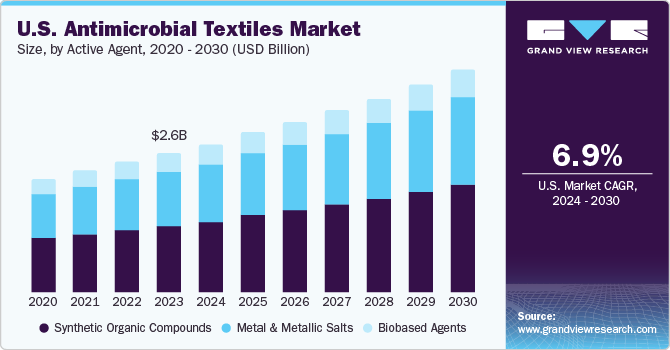
Antimicrobial textiles are effortlessly finding a place in the global textile market due to the steadily growing number of durable and safe antimicrobial finishes. The end-uses of these fabrics can be custom-made to fit the needs of a wide range of consumers across various industries. Mostly, this is quite beneficial for the medical industry. Additionally, the apparel industry can benefit from these fabrics because the products made for these two industries are related.
Key industry players are actively involved in developing new products and technologies, utilizing advanced methods to manufacture cost-effective and harmless products for both consumers and the environment. To meet the performance requirements of antimicrobial textiles, the leading market players are utilizing nanotechnology to develop innovative products, as nanotechnology is capable of obtaining the anticipated performance requirements while retaining the critical properties of these fabrics.
Market Concentration & Characteristics
The industry growth stage is medium and the pace of growth is accelerating. The global antimicrobial textiles market is being dominated by a limited number of big multinational companies that possess the caliber to bring innovations into the global market. The industry players have their own significant research and development efforts; however, these industry participants are entering into alliances with domestic players in order to capture the regional markets, which these big giants can leverage in their global marketplaces.
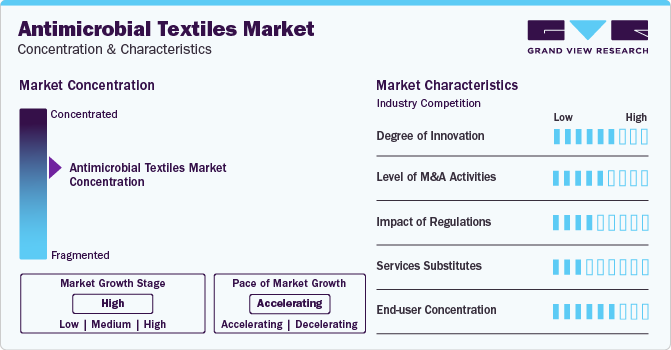
Ongoing advancements in the global antimicrobial medical textiles industry have stemmed in a new breed of antimicrobial medical fabrics. A wide range of biodegradable polymers and natural fibers along with non-biodegradable synthetic polymers is being employed for the development of new products in the antimicrobial medical textiles market. Thus, the degree of innovation is high in the industry.
The threat of substitutes is expected to be low over the forecast period due to the presence of no or less known substitutes in the industry. Manufacturing companies are channeling their efforts to diversify the technologies involved in the manufacturing process to further enhance the production of antimicrobial textiles. Due to the lack of research and development (R&D) initiatives and shrinking R&D budgets, the manufacturing companies are yet to bring any substitute, threatening the growth of the global antimicrobial textiles market.
Active Agent Insights
Synthetic organic compounds was the largest segment and accounted for more than 47.2% of the global revenue share in 2023. The segment is expected to grow at a CAGR of 7.0% over the forecast period. These organic compounds and polymers are designed to inhibit the growth of microorganisms such as bacteria, fungi, and viruses, helping to maintain hygiene and prevent odor in textiles. Synthetic organic compounds include agents such as triclosan, quaternary ammonium salts, and halogenated phenols.
Application Insights
The medical textile segment accounted for a revenue share of over 45.5% in 2023 and is expected to witness significant growth for antimicrobial textiles over the forecast period. The rising prevalence of chronic diseases and upsurge in nosocomial infections worldwide, coupled with growing awareness for better healthcare practices, are projected to fuel the demand for antimicrobial medical fabrics over the forecast period. Ongoing technological advancements, such as the growth of nanotechnology, will further augment the market growth.
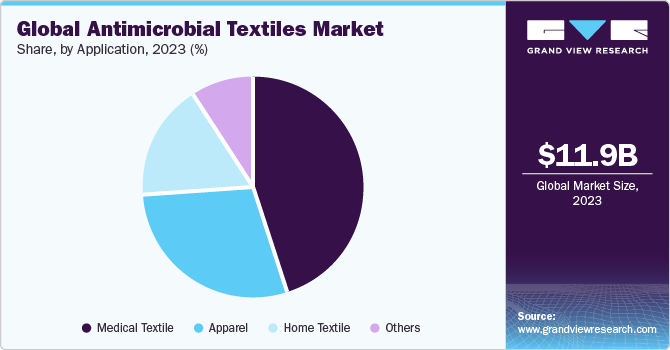
The apparel segment is anticipated to grow at a significant CAGR over the forecast period. Antimicrobial textiles are increasingly used in the activewear and sportswear segment owing to their anti-odor properties. In addition, rising awareness about hygiene coupled with growing concerns about viral and bacterial infections have further supported the consumption of antimicrobial textiles in apparel application.
Regional Insights
The growth of the antimicrobial textiles market in North America is driven by the flourishing medical textile industry, stringent industrial safety regulations, awareness regarding personal health and hygiene, the presence of leading companies, and a large consumer base. There are untapped market opportunities in the transportation, water purification, healthcare, and sports industries, which will further propel the market expansion.
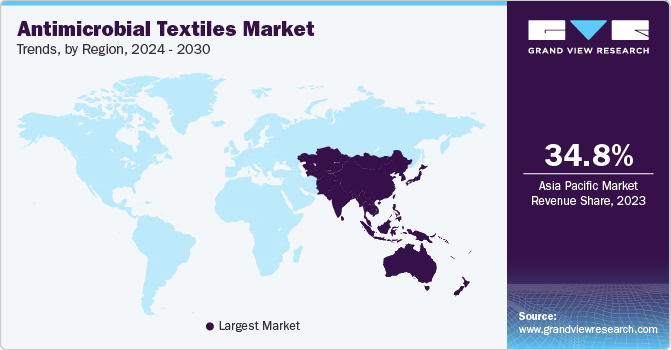
U.S. Antimicrobial Textiles Market Trends
The U.S. antimicrobial textiles market’s growthis driven by the rising awareness regarding new technologies for wound care, the growing diabetic and aging population, and government funding for non-implantable goods are anticipated to propel the growth of the antimicrobial textiles market in the U.S. The market is regulated by the Federal Insecticide, Fungicide, and Rodenticide Act (FIFRA) and the Environmental Protection Agency (EPA).
The Canada antimicrobial textiles market is highly regulated and is subject to stringent standards by Health Canada’s Pest Management Regulatory Agency (PMRA). It ensures public safety, particularly in healthcare and home textiles. The regulatory landscape positively impacts the manufacturing process, and product innovation, and promotes ethical advertising and labeling of products.
Asia Pacific Antimicrobial Textiles Market Trends
Asia Pacific accounted for a revenue share of 34.83% of the global antimicrobial textile demand in 2023, owing to factors including large population density, which increases the risk of bacterial and viral transmission, resulting in increased demand for antimicrobial textiles. In addition, the rising disposable incomes of consumers in economies such as China and India coupled with growing awareness about hygiene in clothing is expected further to increase the demand for the industry over the coming years.
The India antimicrobial textiles market is expected to witness growth over the forecast period.India has a large and rapidly growing population, which can lead to higher incidences of infectious diseases. The growing awareness among people related to the preventative measures to curb these diseases, along with the growing disposable incomes of consumers, is likely to increase the demand for antimicrobial textiles in the country.
The antimicrobial textiles market in China is poised for growth in the forthcoming years. The rising health awareness among consumers coupled with increasing disposable income, private & public sector initiatives promoting hygiene among the population are forecasted to boost the demand for antimicrobial medical fabric over the forecast period. Ongoing advancements in the medical science and fabrics industry in China, coupled with changing demographics and consumer demand, are anticipated to boost the demand.
Europe Antimicrobial Textiles Market Trends
The antimicrobial textiles market in Europe is positively impacted due to the launch of the Circular Economy Action Plan as a part of the Green Deal by the European Commission. Furthermore, the European Union's REACT project addresses antimicrobial acrylic textiles waste management from outdoor awnings and furnishing. Growing focus on developing a green economy and supportive government regulations are projected to drive the market growth over the forecast period.
The UK antimicrobial textiles market is expected to witness growth over the forecast period.England is the birthplace of many modern sports, including cricket, football, rugby, badminton, tennis, boxing, golf, cycling, and motorsports. The demand for antimicrobial textiles is expected to grow due to the growing trend for sports in the UK. Conventional textiles generate bacteria and odor from excessive sweat while playing sports, whereas antimicrobial textiles prevent the growth of bacteria, making them more suitable for sports applications. This is expected to create the demand for these textiles in the coming years.
Central & South America Antimicrobial Textiles Market Trends
The antimicrobial textiles market in Central & South America is anticipated to witness significant growth from 2024 to 2030. It is an emerging market and antimicrobial textiles are being adopted in apparel, healthcare, home textiles, and other sectors.
The Brazil antimicrobial textiles market accounted for a majority of the revenue share in 2023. The industry growth is largely supported by the humid weather conditions in Brazil, which increases the requirement for fabrics that prevent bacteria and odor. In addition, Brazil has a large number of textile manufacturers. It is a major market that exports fabrics to other countries, including the U.S. These factors are anticipated to fuel the demand for antimicrobial textiles in the region.
Middle East & Africa Antimicrobial Textiles Market Trends
The Middle East & Africa antimicrobial textiles market is gaining widespread acceptance for the manufacturing of hospital beddings, uniforms, and towels in the healthcare sector. Consumer awareness about Hospital Acquired Infections (HAI) and the development of natural plant-based antimicrobial coatings are fueling market growth, particularly in healthcare facilities.
The antimicrobial textile market demand in Saudi Arabia is anticipated to grow at a higher rate over the forecast period owing to the climatic condition of the country, including high temperature and humidity, which creates conditions of fungal and bacterial growth, making antimicrobial fabrics a desirable option to maintain freshness and hygiene in clothing. In addition, government initiatives to promote healthcare and hygiene standards are further likely to fuel the demand for antimicrobial textiles.
Key Antimicrobial Textile Company Insights
Some of the key players operating in industry include UNITIKA LTD, Milliken, Indorama Ventures Fibers Germany:
-
UNITIKA LTD is a Japan-based manufacturer and distributor of textiles for various applications. The company operates through three business domains: polymers, performance materials, and fibers & textiles. UNITIKA LTD has a presence in many countries, including Japan, China, Vietnam, Hongkong, Indonesia, Germany, the U.S., and Brazil.
-
Milliken is a producer and supplier of petrochemical products. Its product line includes feedstock, packaging, PET, recycled products, and fibers. The company has 148 manufacturing facilities, which are spread across 35 countries.
Herculite, U-LONG High Tech Textile Co., Ltd., and PurThread Technologies, Inc. are some of the emerging market participants.
-
Herculite is engaged in the design, manufacturing, and consulting of flexible PVC composite textiles. Its product portfolio includes textiles for healthcare, military, industrial, agriculture, marine, tent, and awning.
-
U-LONG High Tech Textile Co., Ltd. produces finished fabric for various applications, including shoes, apparel, bags, home textiles, and industrial textiles. The company offers a vast range of fabrics, including woven, functional, and sustainable textiles.
Key Antimicrobial Textiles Companies:
The following are the leading companies in the antimicrobial textile market. These companies collectively hold the largest market share and dictate industry trends.
- Indorama Ventures Fibers Germany
- Herculite
- UNITIKA LTD
- PurThread Technologies, Inc.
- LifeThreads
- Rajshree Fabrics.
- Baltex
- U-LONG High Tech Textile Co., Ltd.
- Milliken
Recent Developments
- In June 2021, HeiQ Materials AG acquired Life Material Technologies Limited, a Hong-Kong based producer of bio-based antimicrobial additives. This acquisition will allow HeiQ Materials AG to increase its presence in the bio-based antimicrobial and surface hygiene market.
Antimicrobial Textiles Market Report Scope
Report Attribute
Details
Market size value in 2024
USD 12.76 billion
Revenue forecast in 2030
USD 19.04 billion
Growth rate
CAGR of 6.9% from 2024 to 2030
Historical data
2018 - 2022
Forecast period
2024 - 2030
Quantitative units
Volume in tons and revenue in USD billion and CAGR from 2024 to 2030
Report coverage
Revenue forecast, company ranking, competitive landscape, growth factors, and trends
Segments covered
Active agent, application, region
Region scope
North America; Europe; Asia Pacific; Central & South America; Middle East & Africa
Country scope
U.S.; Canada; Mexico; UK; Germany; France; Italy; Spain; China; Japan; India; Indonesia; Brazil; Saudi Arabia; UAE
Key companies profiled
Indorama Ventures Fibers Germany; Herculite; UNITIKA LTD; PurThread Technologies, Inc.; LifeThreads; Rajshree Fabrics; Baltex; U-LONG High Tech Textile Co., Ltd.; Milliken
Customization scope
Free report customization (equivalent up to 8 analysts’ working days) with purchase. Addition or alteration to country, regional & segment scope.
Pricing and purchase options
Avail customized purchase options to meet your exact research needs. Explore purchase options
Global Antimicrobial Textiles Market Report Segmentation
This report forecasts volume & revenue growth at global, regional, and country levels and provides an analysis of the latest industry trends in each of the sub-segments from 2018 to 2030. For this study, Grand View Research has segmented the global antimicrobial textiles market report based on active agent, application, and region:
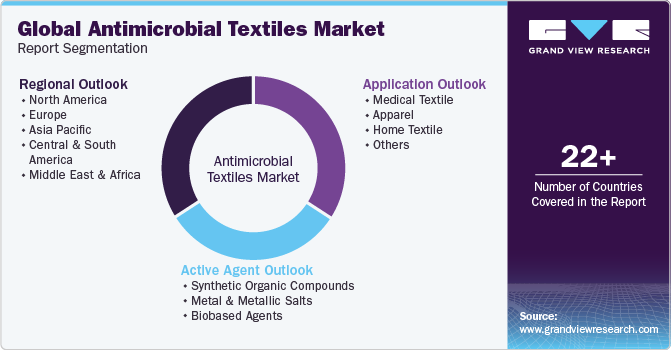
-
Active Agent Outlook (Revenue, USD Billion, 2018 - 2030)
-
Synthetic Organic Compounds
-
Metal & Metallic Salts
-
Biobased Agents
-
-
Application Outlook (Revenue, USD Billion, 2018 - 2030)
-
Medical Textile
-
Apparel
-
Home Textile
-
Others
-
-
Regional Outlook (Revenue, USD Billion, 2018 - 2030)
-
North America
-
U.S.
-
Canada
-
Mexico
-
-
Europe
-
UK
-
Germany
-
France
-
Italy
-
Spain
-
-
Asia Pacific
-
China
-
India
-
Japan
-
Indonesia
-
-
Central & South America
-
Brazil
-
-
Middle East & Africa
-
Saudi Arabia
-
UAE
-
-
Frequently Asked Questions About This Report
b. The global antimicrobial textiles market size was estimated at USD 11.93 billion in 2023 and is expected to reach USD 12.76 billion in 2024.
b. The global antimicrobial textiles market is expected to grow at a compound annual growth rate of 6.9% from 2024 to 2030 to reach USD 19.04 billion by 2030.
b. The medical textile application segment led the market and accounted for over 45.5% of the revenue in 2023. The rising prevalence of chronic diseases and upsurge in nosocomial infections worldwide, coupled with growing awareness for better healthcare practices, are projected to fuel the demand for antimicrobial medical fabrics over the forecast period.
b. Some of the key players operating in the antimicrobial textiles market include Indorama Ventures Fibers Germany, Herculite, UNITIKA LTD, PurThread Technologies, Inc., LifeThreads, Rajshree Fabrics, Baltex, U-LONG High Tech Textile Co., Ltd., Milliken
b. The key factors driving the global antimicrobial textiles market include their ability to reduce the transmission of infection in household and medical environments.
Share this report with your colleague or friend.
![gvr icn]()
NEED A CUSTOM REPORT?
We can customize every report - free of charge - including purchasing stand-alone sections or country-level reports, as well as offer affordable discounts for start-ups & universities. Contact us now
![Certified Icon]()
We are GDPR and CCPA compliant! Your transaction & personal information is safe and secure. For more details, please read our privacy policy.
We are committed towards customer satisfaction, and quality service.
"The quality of research they have done for us has been excellent."





